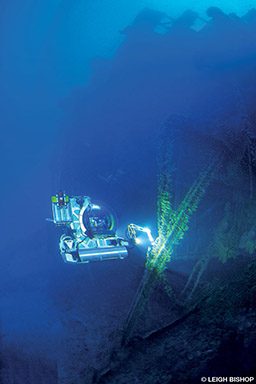Modern technology brings enhanced opportunities for exploring shipwrecks. But deep wreck expeditions are complex undertakings that require a team of technical divers prepared to work with literally tons of advanced equipment both underwater and topside. The 2016 centenary dives on the Britannic involved divers working alongside submersibles and remotely operated vehicles (ROVs) at great depths.
Compounding the need to employ specialized equipment and detailed operational protocols was the filming of the expedition for both a BBC television special and a big-budget Russian documentary to be distributed globally.
Conducting deep ocean dives with free-swimming technical divers has long been the subject of controversy. Members of the commercial diving industry deemed the 1994 Lusitania dives by Starfish Enterprise, a British deep wreck diving team of the 1990s with whom I did my first dives on the Britannic, unsafe due to a lack of diver safety protocols and the absence of an onsite recompression chamber. The 2016 Britannic endeavour was characterized by careful planning, substantial collaboration and detailed safety protocols.
Leadership
Americans Richie Kohler and Evan Kovacs, in conjunction with a group of Russian divers, planned to take deep wreck exploration to a new level. They had made a single checkout dive the year before with the intention of conducting a significant project with the Russians in 2016. Their diver support and safety plan restored my confidence in the complicated endeavor of deep mixed-gas rebreather diving, which had been shaken by the death of my friend Carl Spencer on the Britannic in 2009.
Equipment and Operations
A key safety feature of the dive operations was a commercial wet diving bell. A 70-page standard operating procedure (SOP) document outlined the expedition’s safety protocols.

Only four divers would be in the water on dive days, each using his own choice of rebreather with a team-chosen diluent of 9/73 trimix. An emergency bailout profile would be based on a carried three-gas protocol: 13/60 trimix, 20/30 trimix and 100 percent oxygen. All other gas would be in the diving bell, the main point of bailout at depth.
Diving-bell operations would be predicated by the surface vessel maintaining a three-point mooring position to keep the bell on station. In the case of a lost mooring or a drastic shift in weather conditions during the 45-plus-minute bottom phase, the diving bell could shift from its position above the wreck to beyond where the divers could see it. Protocols for this scenario would be supported by ROVs and submersibles that oversaw and maintained contact with the dive team — the submersible pilots would direct the divers to an off-station diving bell in mid-water, out of sight of divers on the wreck.
Because the diving bell was a critical element of the safety protocols, the team had to become familiar with all aspects of its operation. Each exploration diver would have to understand oxygen partial pressure (PO2) calibration and venting, verbal and light communications, buoyancy adjustments, onboard and surface-supplied emergency open-circuit gas, bell master responsibilities and management of an unconscious diver.
One nominated diver would be the dedicated bell master for the dive and communicate with both the dive team and the topside crew. The bell master would confirm each diver was clear to ascend and move the bell only when the slowest profile had cleared the stop.
Any diver ascending into the open bell at depth had to confirm the PO2 was within the acceptable range before going off his loop (rebreather) and breathing in the atmosphere of the bell. At the maximum depth of the bell (about 300 feet) the atmosphere in the bell would be hyperoxic with a PO2 in excess of 2.0. Although the vent gas was air, the PO2 in the bell could be dropped by venting bailout gas into the bell or having the topside crew pump down bottom gas. With time spent in the bell, exhaled gas from a diver’s loop would require a venting phase to prevent changes in buoyancy. In rough seas, buoyancy adjustments could also be used to eliminate the hard recoil of the cables if the bell began bouncing with the ocean.
All diving operations were conducted under the watchful eye of the topside control center via the ROV. Should anyone actually get lost on the wreck, the submersible pilots could simply hold up a directional sign with one hand while eating a sandwich with the other.
Emergency Procedures
For the team of technical divers, using a bell was a new approach to a mixed-gas project. Many emergency scenarios had to be considered and factored into the SOP, including central nervous system oxygen toxicity, air embolism and loss of consciousness. An unconscious diver drill was conducted topside to provide practice securing a diver in the bell with a ratchet strap, maintaining an open airway and performing chest compressions.

In the scenario a diver “found unconscious” at depth was quickly placed inside the bell and strapped against the bulkhead with his head above water. The rescue divers cut away his equipment and secured him. The bell master communicated the mock emergency to the surface and followed the directions of the topside hyperbaric doctor. As directed, the dive team took turns maintaining an airway and performing chest compressions. The rescue divers remained on their loops in the bell, and the topside crew regulated the atmosphere in the bell for the injured diver.
The plan dictated that an injured diver should ascend with the dive team’s decompression schedule until the topside team determined they should lift the injured diver out of the water. A support diver would descend to the bell and take over doing compressions and maintaining an open airway, while the dive team transitioned to the ROV downline. The bell, along with a support diver, would be lifted out of the water and the injured diver treated, after which the bell would be returned to the water for the remaining dive team’s decompression phase.
Further protocols covered separated- and lost-diver scenarios as well as out-of-gas emergencies. When in doubt, all a diver had to do in an emergency was swim back to the bell, which would be located just above
the wreck.
The bell was loaded with built-in cylinders filled with the gases required for the dive. Each cylinder was equipped with multiple regulators on long hoses. Additional cylinders of deep and intermediate gas mixes were also available.
Algorithm Selection
Because of the very strong surface currents that can occur over the Britannic, decompression model safety factors were considered, and the best protocol was determined to be one that would promote completion of as much decompression as possible at deeper depths where the currents would not be as strong. Thus we were on the hunt for bubble-based deep-stop protocols. The varying permeability model (VPM-B) and reduced gradient bubble model (RGBM) algorithms used to dictate the deep stops on previous expeditions were configured with a 10 percent increase in the “nominal” critical radii of helium and nitrogen bubbles. These models generated an initial ascent rate and a deep-stop profile fairly close to a Bühlmann model with a low gradient factor (e.g., 5 percent). Since these models were based on real bubble mechanics and not fudged to Bühlmann, we figured them to be physiologically better. As a sensibility check we compared the total run times of these profiles and found them to be fairly similar to those generated using the Drogon Dive Planner (DDPLAN) with 5/85 gradient factors, which had been used reasonably successfully on previous deep projects.
With rebreather scrubber durations taken into consideration, run times were capped at 40-50 minutes. Both the Inspiration and JJ scrubbers had been shown to be good for at least five hours on deep warm-water dives, due to their efficiency in warm water in conjunction with the divers’ work rate, which was very low except during the first 30-40 minutes on the bottom.
The Expedition
At the end of an exciting and successful expedition, on our last day of diving I joined three other divers — Italian Edoardo Pavia, American Michael C. Barnette and fellow Brit Richard Stevenson — for a tour around the wreck in a single dive. The visibility was in
excess of 150 feet as we cruised the decks of the massive liner using lithium-powered Suex diver propulsion vehicles. We passed by open and covered promenade decks, under huge lifeboat davits silhouetted above us by the midday sun and over the seabed debris field to a maximum depth of almost 400 feet. We passed the three monster propellers and cruised along the stern veranda café. Each scene was truly breathtaking.
Watching from the best seat in the house, Richie Kohler followed us in the Triton 3300/3 submersible alongside pilot Dmitry Tomashov, while Russian cinematographer Sergey Machilskiy caught every frame of our journey using Red Epic 5K cameras. Circumnavigating the Britannic during its centenary year surrounded by such incredible technology was without a doubt the greatest dive of my life.
Tomashov’s father, Evgeny, skillfully maneuvered his unique, specially built one-man minimal-displacement submersible into various positions, lighting up scenes such as the propellers and bow. It was like we had dived into a science fiction movie, but as Kohler remarked as he climbed from the submersible hatch hours later, “Science fiction? No, I think you will find, Leigh, that dive you just made was science fact.”
Explore More
© Alert Diver — Q4 Fall 2016

